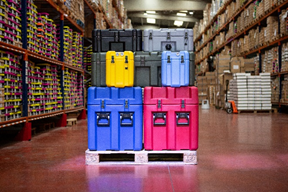As consumers, it is not uncommon for many of us to overlook what it takes for the products we consume to be made. For most products, this requires raw materials, such as oil, lumber, metals and minerals. For Peli, for example, the primary raw material used in the manufacture of our high-performance cases is a certain type of plastic.
As one might imagine, the price of raw materials for a manufacturing organisation can really influence how profitable a company can be, and thus, the impact of raw materials prices can impact the price we pay for a given good. Having said that, we decided to put together a quick guide on what influences raw material prices, to give you an idea of what it takes to manufacture a product from start to end.
What are raw materials?
Firstly, what exactly is a raw material? Raw materials are materials or substances that are used in the production or manufacture of goods. Some examples of raw materials include steel, oil, corn, grain, gasoline, lumber, forest resources, plastic, natural gas, coal, metals and minerals. Raw materials can be considered direct or indirect raw materials. Direct raw materials are those that are used in the manufacturing process of the final product, while indirect raw materials are not part of the final product but are used in the production process.
Raw materials are also commodities that can be bought and sold on commodity markets around the world. The London Metal Exchange (LME) for example is one of the oldest commodities exchange markets in the world. The LME is the trading and price-formation venue of choice for industrial and precious metals globally. Through these exchanges, traders can buy and sell raw materials because they are factors of production, as are labour and capital.
How Supply and Demand influence raw materials prices
Although there are a number of more specific reasons that raw materials may be more or less costly, supply and demand is perhaps the best way to think about it. If you have ever taken an introductory course in economics, it is likely that you have heard of the law of supply and demand. This essentially states that as supply for a given good increases, price decreases and conversely if supply decreases, prices increase. On the other side, we also have demand, which represents the theoretical demand of the market for a given good. If demand increases, prices will also increase and if demand decreases, prices will decrease.
To provide an example, crops for agricultural raw materials are extremely susceptible to changes in weather, which can greatly impact the supply of said raw materials. If there is a drought or massive storm that wipes out crops, supply will decrease, meaning prices for that raw material will increase.
Looking at demand, its impact is often in conjunction with supply. Thus, materials that are in high demand, but also in high supply, will tend to have lower prices, largely due to market competition. But to illustrate how the law of demand works with an example. Consider a company that produces a specific type of shirt that is extremely popular. If that shirt is made from specific textile, that textile’s price will increase due to the increased demand of the popular shirt.
Having stated that, we can move into more concrete examples of raw material price influencers.
Source of the material
This is one of the most expensive aspects of obtaining a raw material. If mines run low on a certain metal or mineral, if a harsh winter kills crops, if there is a massive forest fire that burns down acres of lumber, the supply, or availability, of a raw material is reduced. The demand will likely remain at the same level or even increase, while supply has decreased, and thus, prices increase.
Transportation
The costs associated with transportation can significantly affect the prices of raw materials as well. This is especially true as far as exporting and importing goods is concerned. If there are taxes or levies imposed by governments on the movement of goods in and out of a country or region, the raw material price will be impacted.
Of course, there are also other forces involved such as supply chain disruptions, which we have seen all over the world in the past year or so. If it gets harder to transport goods, supply can decrease due to the onerous nature of delivering the goods. This increases prices.
Additionally, most modes of transportation for raw materials require fuel, such as transportation by air, land, rail, or sea. If fuel prices increase, then prices of raw materials that are transported will also increase.
Labour
We also have to take into account the cost of labour. All throughout the supply chain, from raw material sourcing to transportation and delivery of the raw material, labour is involved. If there is a shift in labour along the way, there will likely be a shift in raw material pricing. For example, if there is a shift in labour that decreases the work force, such as a labour strike, there will be less labour to source or ship the material, thus decreasing supply and impacting price.
Cost of labour is also one of the most controversial topics as far as raw material pricing goes. Much of the resource extraction around the world is done in developing nations. The manufacturing and refining of the raw material is also often done in these nations. In these markets, labour is widely available and also much less costly. It is thought by critics that people working in these mines and fields are not paid fair wages and are made to work in unsafe working conditions compared to those that one would expect from developed nations. However, if these companies were to pay the wages similar to those of workers in the developed nations and adhere to the standards for working conditions that are typical in developed nations, the cost of labour would be much higher and thus so would the price of the raw materials.
Purity/quality
Another interesting point to consider with regard to raw material pricing is the purity of the materials. Many raw materials are extracted and refined to varying degrees of purity or quality. To take oil as an example, you may have heard of the terms, “sweet” and “light” or “sour” and “heavy” crude oils. Without getting into too much detail, sweet and sour refers to the sulphur content of oil. The "sweeter" the oil, the less sulphur content and thus more purity.
The terms “light” and “heavy” refer to water density of oil. The lower the density, the easier it is for it to be refined into gasoline or diesel fuel. Conversely, the higher the density, or “heavier,” the oil is, the harder it is to refine.
To use another example that the layperson can better understand, let’s look at coffee. That is, the coffee beans. Arabica coffee beans are thought to be of higher quality thus they will likely be more expensive. Whereas Robusta coffee beans, which tend to be used in cheaper pre-ground and instant coffee varieties, are usually of lower quality and thus will be less expensive.
Substitute Goods
Often the price of a specific good can be impacted due to the price of another good shifting. To use the coffee example once again, this time a real-life example. Back in 2017, a drought in Brazil, the world’s largest coffee producer, seriously impacted the supply of Robusta coffee beans. While at the same time, Vietnam and Indonesia saw too much rain, which also affected the supply of Robusta coffee beans. With the supply of Robusta coffee beans seriously constricted, buyers turned to Arabica coffee beans as a substitute. This rise in the demand for Arabica beans, along with the decrease in supply of Robusta beans, saw the price of Arabica coffee beans increase.
Acts of God
Although this has been touched on already, there are any number of “acts of God” that can impact the prices of raw materials. These usually come in the form of natural disasters such as tornadoes, hurricanes, earthquakes, forest fires and many more. If this impacts the supply or demand of a given raw material, the price can be significantly impacted.
What do raw materials prices mean for the consumer?
Although it may not seem like it, these shifts in the price of raw materials can significantly impact the price that one pays for a finished good that uses raw materials as inputs in the production process. So, next time you notice a price for something you regularly consumer increase, give a little thought to raw materials prices, which may be the culprit.
Much of raw material pricing has to do with transportation of goods, as described above. Damaged goods in transit can be costly to an organisation. Peli Products is the world leader in the manufacture of high-impact and damage resistant, repeat-use packaging. If you would like to know more about how Peli can help you with your packaging needs, click on the button below to see our entire case catalogue.





.png)















Post a comment